Presidium of the Supreme Soviet facts for kids
Quick facts for kids Presidium of the Supreme SovietПрезидиум Верховного Совета |
|
|---|---|
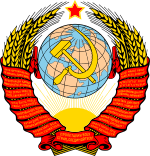 |
|
| Type | |
| Type | |
| History | |
| Established | 1938 |
| Disbanded | 1990 |
| Preceded by | Central Executive Committee of the Soviet Union |
| Succeeded by | President of the Soviet Union |
| Seats | 39 |
| Elections | |
| Election by joint session of both houses of the Supreme Soviet | |
| Meeting place | |
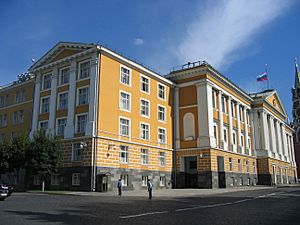 |
|
| Kremlin Presidium, Moscow Kremlin 55°45′08″N 37°37′12″E / 55.7523°N 37.6200°E |
|
The Presidium of the Supreme Soviet (Russian: Президиум Верховного Совета, romanized: Prezidium Verkhovnogo Soveta) was an important group in the Soviet Union (USSR). It was like a special committee chosen by the main parliament, called the Supreme Soviet. The Presidium acted on behalf of the Supreme Soviet when the main parliament was not meeting.
According to the Soviet Constitutions of 1936 and 1977, the Presidium of the Supreme Soviet served as the country's "collective head of state." This means it was a group of people, not just one person, who held the highest power in the country. The Presidium was always responsible to the Supreme Soviet for everything it did.
Similar groups also existed in all the different republics that made up the Soviet Union. For example, there was a Presidium for the Supreme Soviet of the Russian SFSR. These groups worked in much the same way as the main Presidium.
When they were discussing the 1936 Constitution, there was an idea to let everyone in the country vote for the chairperson of the Presidium. But Joseph Stalin disagreed. He said that the Soviet system should not have one powerful president elected by everyone. Instead, he believed the "President of the USSR" should be a group – the Presidium. This group, including its chairperson, would be chosen by the Supreme Soviet and would be answerable to it. Stalin thought this way of doing things was more democratic and safer for the country.
Contents
Choosing the Presidium Members
The Presidium of the Supreme Soviet was chosen by the Supreme Soviet itself. This happened during a special meeting where both parts of the Supreme Soviet came together. The members of the Presidium were chosen for the same amount of time that the Supreme Soviet was in office.
The Presidium of the Supreme Soviet of the USSR had several key roles. It included a chairman, a first vice-chairman (after 1977), and 15 other vice-chairmen (one from each Soviet republic). It also had a secretary and 20 other members. This whole group was responsible to the Supreme Soviet for all its actions.
From 1938 to 1989, the chairman of the Presidium was officially considered the head of state of the Soviet Union. Outside the Soviet Union, people sometimes called this person the "President of the USSR."
The Presidium Building
The main building where the Presidium met was located inside the famous Moscow Kremlin. It was even called the Kremlin Presidium.
What the Presidium Could Do
The powers of the Presidium changed over time. Here's what it could do at different points:
Powers at the Beginning (1936 Constitution)
When it was first created under the 1936 Constitution, the Presidium of the Supreme Soviet had many important jobs:
- It could issue official rules or orders, called ukases.
- It could explain what current Soviet laws meant.
- It could end the Supreme Soviet's term and call for new elections. It could also call for a national vote (referendum) on important issues.
- It could cancel rules made by the Council of Ministers if they didn't follow the law.
- It could remove the Chairman of the Council of Ministers and appoint new ministers when the Supreme Soviet wasn't meeting. These appointments would later need approval from the Supreme Soviet.
- It could create Soviet orders and medals and decide who received them.
- It could create special honorary titles for people.
- It had the power to pardon people who had committed crimes.
- It could appoint and remove leaders of the Soviet Armed Forces.
- It could set up military and diplomatic ranks.
- It could declare a general or partial mobilization, meaning calling up people for military service.
- It could declare war if the USSR was attacked or if it needed to help allies.
- It could approve or cancel international agreements signed by the USSR.
- It represented the Supreme Soviet when dealing with parliaments in other countries.
- It could appoint and remove Soviet representatives in foreign countries.
- It received official documents from foreign diplomats working in the USSR.
- It could declare martial law (military rule) in certain areas or across the whole country to protect the USSR or keep order.
The Presidium also handled questions about becoming a Soviet citizen, losing citizenship, or giving it up voluntarily.
When the Supreme Soviet was not meeting, the Presidium took over its regular duties. It could also issue rules that had the force of law. These rules were supposed to be approved by the Supreme Soviet at its next meeting. If the Supreme Soviet didn't approve them, they would be canceled. In reality, the Supreme Soviet didn't meet very often (usually only one week a year). This meant that the Presidium's rules often acted as real laws. Sometimes, the Politburo, a powerful group, would even make major laws through the Presidium without the Supreme Soviet's formal approval.
Powers at the End (1977 Constitution)
By the time the Soviet Union was ending, and the Presidium was abolished, its powers had changed. According to the 1977 Constitution, its main jobs were:
- To organize the work of the Supreme Soviet.
- To prepare for meetings of the Congress of People's Deputies and sessions of the Supreme Soviet.
- To help coordinate the work of the Supreme Soviet's committees.
- To organize nationwide discussions about new laws and other important state matters.
Many of the Presidium's earlier powers were given to the full Supreme Soviet and to the new position of President of the USSR.
Chairmen of the Presidium
| No. |
Name (Birth–Death) |
Portrait | Term of office | Supreme Soviet Convocations |
|---|---|---|---|---|
| Chairman of the Presidium of the Supreme Soviet (1938–1989) | ||||
| 1 | Mikhail Kalinin (1875–1946) |
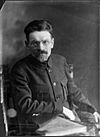 |
17 January 1938 – 19 March 1946 | 1st Convocation |
| 2 | Nikolay Shvernik (1888–1970) |
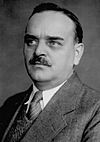 |
19 March 1946 – 15 March 1953 | 2nd–3rd Convocation |
| 3 | Kliment Voroshilov (1881–1969) |
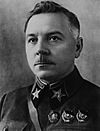 |
15 March 1953 – 7 May 1960 | 3rd–5th Convocation |
| 4 | Leonid Brezhnev (1906–1982) |
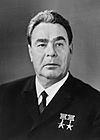 |
7 May 1960 – 15 July 1964 | 5th–6th Convocation |
| 5 | Anastas Mikoyan (1895–1978) |
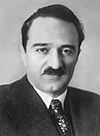 |
15 July 1964 – 9 December 1965 | 6th Convocation |
| 6 | Nikolai Podgorny (1903–1983) |
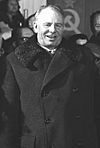 |
9 December 1965 – 16 June 1977 | 6th–9th Convocation |
| (4) | Leonid Brezhnev (1906–1982) |
 |
16 June 1977 – 10 November 1982 | 9th–10th Convocation |
| — | Vasili Kuznetsov (1901–1990) |
 |
10 November 1982 – 16 June 1983 | 10th Convocation |
| 7 | Yuri Andropov (1914–1984) |
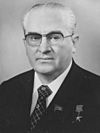 |
16 June 1983 – 9 February 1984 | |
| — | Vasili Kuznetsov (1901–1990) |
 |
9 February 1984 – 11 April 1984 | |
| 8 | Konstantin Chernenko (1911–1985) |
 |
11 April 1984 – 10 March 1985 | 11th Convocation |
| — | Vasili Kuznetsov (1901–1990) |
 |
10 March 1985 – 27 July 1985 | |
| 9 | Andrei Gromyko (1909–1989) |
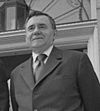 |
27 July 1985 – 1 October 1988 | |
| 10 | Mikhail Gorbachev (born 1931) |
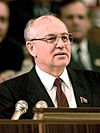 |
1 October 1988 – 25 May 1989 | 11th–12th Convocation |
| Chairman of the Supreme Soviet (1989–1990) | ||||
| Mikhail Gorbachev (born 1931) |
 |
25 May 1989 – 15 March 1990 | 12th Convocation | |
| 11 | Anatoly Lukyanov (1930–2019) |
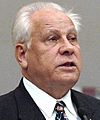 |
15 March 1990 – 4 September 1991 | 12th Convocation |
Vice Chairmen of the Presidium
| No. |
Name (Birth–Death) |
Portrait | Term of office | Convocations |
|---|---|---|---|---|
| First Vice Chairman of the Presidium of the Supreme Soviet (1977–1989) | ||||
| 1 | Vasili Kuznetsov (1901–1990) |
 |
7 October 1977 – 18 June 1986 | 9th–11th Convocation |
| 2 | Pyotr Demichev (1917–2010) |
— | 18 June 1986 – 1 October 1988 | 11th Convocation |
| 3 | Anatoly Lukyanov (1930–2019) |
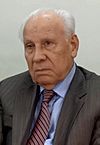 |
1 October 1988 – 25 May 1989 | 11th–12th Convocation |
| Vice Chairman of the Supreme Soviet (1989–1990) | ||||
| Anatoly Lukyanov (1930–2019) |
 |
25 May 1989 – 15 March 1990 | 12th Convocation | |
Images for kids
See also
 In Spanish: Presídium del Sóviet Supremo de la URSS para niños
In Spanish: Presídium del Sóviet Supremo de la URSS para niños


